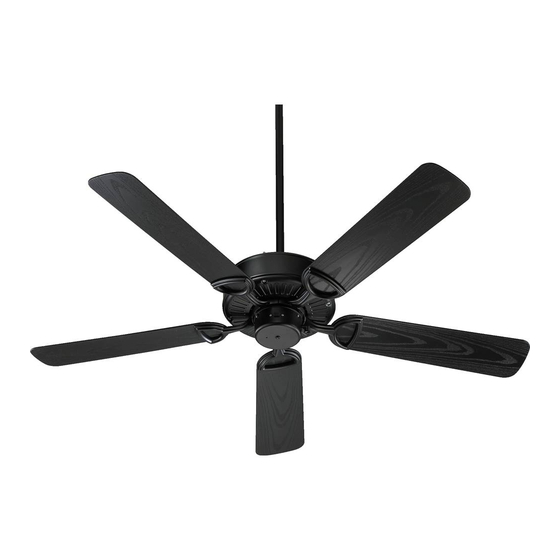
Subscribe to Our Youtube Channel
Summary of Contents for Savoy House M2011 Series
- Page 1 56” CEILING FAN OWNER'S MANUAL READ AND SAVE THESE INSTRUCTIONS MODEL: M2011XX FAN RATING AC 120V. 60Hz UL LISTED MODEL : YG893...
-
Page 2: Tools And Materials Required
1. TOOLS AND MATERIALS REQUIRED Philips screw driver Blade screw driver 11 mm wrench Step ladder Wire cutters 2. PACKAGE CONTENTS Unpack your fan and check the contents. You should have the following items: a. Set of blades assembly (4) b. -
Page 3: Safety Rules
3. SAFETY RULES 1. To reduce the risk of electric shock, insure 10. Do not use water or detergents when electricity has been turned off at the circuit cleaning the fan or fan blades. A dry dust breaker or fuse box before beginning. cloth or lightly dampened cloth will be suitable for most cleaning. -
Page 4: Mounting Options
4. MOUNTING OPTIONS If there isn't an existing UL listed mounting box, then read the following instructions. Disconnect the power by removing fuses or turning off circuit breakers. Secure the outlet box directly to the Outlet box building structure. Use appropriate fasteners and building materials. -
Page 5: Hanging The Fan
5. HANGING THE FAN Hanger REMEMBER to turn off the power. Follow the bracket steps below to hang your fan properly: Step 1. Remove the decorative canopy Ceiling canopy bottom cover from the canopy by turning the cover counter clockwise. (Fig. 5) Canopy Step 2. -
Page 6: Make The Electrical Connections
6. MAKE THE ELECTRICAL CONNECTIONS WARNING: To avoid possible electrical shock, After connecting wires, spread them apart so be sure electricity is turned off at the main that the green and white wires are on one fuse box before wiring. side of the outlet box and the black wire is on the other side. -
Page 7: Finishing The Installation
7. FINISHING THE INSTALLATION Step 1. Tuck connections neatly into ceiling outlet box. Outlet box Step 2. Slide the canopy up to hanger bracket and place the key hole on the canopy Hanger bracket over the screw on the hanger bracket, turn canopy until it locks in place at the narrow Screws section of the key holes. - Page 8 9. INSTALLATING THE MOUNTING PLATE Step 1. Remove the 1 of 3 screws from the mounting ring and loosen the other 2 screws. (Do not remove) Step 2. Place the key holes on the mounting plate over the 2 screws previously loosened from the mounting ring, turn mounting plate until it locks in Mounting ring...
- Page 9 11. OPERATING INSTRUCTIONS F. The " " button is used to set the fan Insert the 3 volt battery (included) and make forward or reverse, press the button sure the battery is properly seated with the forward (for warm weather) or reverse Positive + sign facing up.
- Page 10 Pairing Process: The auto-learning process will only initiate This receiver provides the following protective within the first 60 seconds of supplying power function: to the fan. 1. Lock Rotor Position: The DC motor has a Beginning with the fans power off, restore built-in safety against a stalled or locked rotor power to the fan.
-
Page 11: Care Of Your Fan
Speed settings for warm or cool weather depend on factors such as the room size. Ceiling height, number of fans and so on. NOTE: To operate the reverse function on this fan, press the reverse button while the fan is running. Warm weather - (Forward) A downward air- flow creates a cooling effect as shown in Fig. -
Page 12: Troubleshooting
13. TROUBLESHOOTING Problem Solution Fan will not start. 1. Check circuit fuses or breakers. 2. Check line wire connections to the fan and switch wire connections in the switch housing. CAUTION: Make sure main power is off. 3. Check to make sure the dip switches from the transmitter and receiver are set to the same frequency.
















Need help?
Do you have a question about the M2011 Series and is the answer not in the manual?
Questions and answers